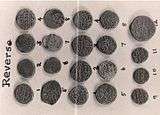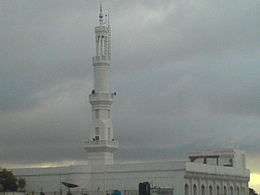Erwadi
Erwadi is a village in Ramanathapuram District, Tamil Nadu, a state in South India. It belongs to Kilakarai Taluk and town panchayat. The village is the location of the grave and shrine of Qutbus Sultan Syed Ibrahim Shaheed Badusha, the previous ruler of Medina. Erwadi also belongs to Kadaladi assembly constituency, which is a part of Ramanathapuram (Lok Sabha constituency). However, after the delimitations in 2009, Erwadi has been joined to the Ramanathapuram assembly constituency. Although a small town, Erwadi is the second largest contributor for the revenue of Ramanthapuram District.
Erwadi Erwadi Dargah shariff | |
|---|---|
village | |
 Erwadi Dargah | |
 Erwadi Location in Tamil Nadu, India | |
| Coordinates: 9.2082197°N 78.7100988°E | |
| Country | |
| State | Tamil Nadu |
| District | Ramanathapuram district |
| Languages | |
| • Official | Tamil |
| Time zone | UTC+5:30 (IST) |
| Website | www |
History
The war

Sultan Syed Ibrahim Shaheed sent Sikandar Badusha to offer Islamic teachings to the Pandiya ruler, Thiru Pandiyan, in Madurai but he refused to accept them and waged war. Shaheed's troops won and Sultan Sikandar Badusha was throned in Madurai. Shaheed's troops marched towards Bouthramanickapattinam. Shaheed Badusha offered Islam to King Vikrama Pandiyan, who vehemently refused and asked Shaheed to leave the kingdom. Shaheed refused to leave without converting them to Islam. Vikrama Pandiyan declared war. A very violent war consisting of about 10 battles, each lasting around 3–4 days, was waged. All of the family members of Shaheed Badusha were killed, including his only son Syed Abutahir, his brother Syed Ismail, his brother-in-law Zainul Aabideen and many of Shaheed Badusha's martyrs and ministers, including Amir Abbas of Rome, Abdul Qadir Mujahid, Muhaiyaddeen, Aboobakkar Abdul Hakkim, Abdullah, Shamsuddin of Makkah, Qamaruddin, Nooruddeen, Muhammadh Yusuf, Jafar Sadiq, Rome Syed Ahmad, Zulfaqar Ali, Chanthana Peer of Turkey, Abdul Qadir Gilani, Abdul Qadir Samadaani, Pathan Sahib, Hamza Basheer, and Uvaisul Hasan Ridwanullahi Ta'ala Alaihim Ajmaeen.[1] Finally, King Vikrama Pandiyan and his sons Indra Pandiyan and Chandra Pandiyan were killed and Shaheed won the war, claiming the throne of Bouthiramanickapattinam. He ruled the province for twelve years and spread Islam all over south Tamil Nadu. Coins struck during the rule of Sultan Syed Ibrahim Shaheed have been found by archeologists.[2]
The peace
The rivalry between King Vikrama Pandiyan's and Shaheed's supporters slowly fizzled, due to the huge loss of life sustained in the war, including King Pandiyan, as well as the capture of Bouthiramanickapattinam. All citizens, irrespective of caste, creed, religion or family, were treated equally; hence, citizens were happier and there was no war.
The royal wedding of the crown prince
During Shaheed Badusha's rule in Bouthiramanickapattinam Province, the neighbouring rulers came together under the leadership of Shaheed Badusha. During the end of his rule, Shaheed solemnized the marriage of the crown prince Badusha Syed Ishaq, his brother's son, with Sayyida Zainab, the daughter of his sister Rabiaa Amma. The wedding was a spectacular event. Thousands of elephants, Arabian horses, and camels came in procession. The royal fort was illuminated grandly. Lights were lit all over the Bouthramanickapattinam Province for a week. All citizens of the province were treated with complete feasts for 3 days. Thousands of sheep were slaughtered for the grand feasts.
Separation of provinces
Twelve years later, King Tiru Pandiyan came from Madurai with a larger army and assassinated Shaheed Badusha in order to recapture the throne. The king Tiru Pandiyan was killed in the war. Badusha Syed Is'haq (Shaheed Badusha's brother Syed Ismail Badusha's son) and Pandiyan prince Jamara Kolakalap Pandiyan split the kingdom. The rivalry between the Arabs and Pandiyans came to an end when both signed a pact, stating that Arabs (descendants of Shaheed Badusha) would rule Bouthiramanickapattinam Province and the Pandiyans would rule Ramanathapuram Province. Syed Is'haq, Syed Ibrahim, Syed Baqir, Syed Qasim, Syed Tahir Ridwanullahi Ta'ala Alaihim Ajmaeen and other descendants of Sultan Syed Ibrahim Shaheed have ruled the Bouthiramanickapattinam Province, while Regunatha Sethupathi, Kilavan (Kizhavan) Sethupathi, Vijaya Regunatha Sethupathi, Muthu Regunatha Sethupathi, Muthuramalinga Sethupathi, Bhaskara Sethupathi, Kumaran Sethupathi and other descendants of Sethupathi have ruled Ramanathapuram Province. This arrangement continued to be implemented until the 17th century, when the British East India Company started occupying India.
Religious importance
Al Qutbul Hamid wal Gausul Majid Badhusha Sultan Syed Ibrahim Shaheed, king of Madinah and 18th generation descendant of the Islamic prophet Muhammad, is said to have traveled to Erwadi, erstwhile Bouthiramanickapattinam, during his journey to India in the early 12th century to spread Islam according to Muhammad's wish.[3]
Shuhadaas and Waliyatullahs in Erwadi


The graves of Emperor Sulthan Syed Ibrahim Shaheed Badusha along with his kith and kin is found in the main dargah campus, along with a large mosque. The holy graves of other important Shuhadaas and in laws of Badusha Sulthan Syed Ibrahim Shaheed are also found on the premises. It also contains a minaret of around 250 feet (76 m) height that can be viewed from the shores of Ramanathapuram District and acts as a virtual lighthouse to the fishermen in Ervadi and the adjacent villages.
Shuhadaas in the main dargah
The main shrine or Dargah in Erwadi is among the holiest places in Tamil Nadu because it is mixed with the soil of Madinah and is an important site for pilgrimage. Qutb Sulthan Syed Ibrahim Shaheed and most of his family members, close relatives and other shuhadaas' graves are found in the main Dargah. The big hall of the shrine of Sultan Syed Ibrahim Shahid was constructed by Eiatibar Khan, during the time of the Nawab of Arcot. There is a flag throne to the south of the main entrance of the dargah. The flag throne is built surrounding the grave of Begum, wife of Eaitibar Khan who constructed the Dargah. The main Dargah has three entrances. It is fully open except for the dargahs.
Kattupalli Shuhadaas
Kattupalli is one of the main places where the war between Pandyas and Arabs was held. It is also the graveyard of Arabs where the Dargahs of all important ministers of Sulthan Syed Ibrahim Shaheed badhusha are found. It is in the northern side of the main dargah within 0.5 km. Kattupalli accommodates the crowd of people that gathers during the Sandanakoodu urus festival.
Ervadi Santhanakoodu Festival

The annual Santhanakoodu festival is held at Ervadi dargha, Ramanathapuram district during the Islamic month of Dhu al-Qi'dah commemorating the shahadat anniversary of Qutb Sulthan Syed Ibrahim Shahid badhusha and is celebrated together by Hindus and Muslims.[4] The Deventhirakula velalar, Yadavas, Parayars, Dalits, Adi Dravidas and the Fishermen community bear the duty of Carrying the Chariot, holding light lamps, putting crackers while the Levvais (Dargah Huqdar Mujavirs) take care of religious duties such as reciting Moulid sheriff, Dua smearing sandal on the roula and praying for the welfare of pilgrims.
Transport
The nearest major town to Erwadi is Kilakarai, at a distance of 27 km, which itself falls on NH 49 from Madurai to Rameswaram. Ramanathapuram is the nearest railway station, connecting the village to all major cities in Tamil Nadu. Erwadi is well connected with the border ports of Bay of Bengal as a junction point of fishing steamers.
Education
Following is a list of schools in Erwadi:
- Markazu Sultaniyya
- S.A.B.M.H Government Higher Secondary School
- Elite Matriculation school
- Kadaladi Union Middle School Chinna Ervadi
See also
- Karseri
- Kattupalli
- List of Islamic shrines in Tamil Nadu
- Madurai Maqbara
- Manamadurai
- Meesal
- Melakkal
- Natham (Keelakarai)
- Palli chandai
- Sundaramudayan
- Thachu oorani
- Thiruparankundram
- Thiruparankundram Dargah
- Thiruvedagam
- Vaippar
- Valinokkam
References
- Vol.1 Edition 6, Mathan 4 Page 42 of Failul Majid Fi manaaqibi Shaheed written by Syed Ibrahim Levvai Aalim and published by Ameer Batcha Aalim Publications, Erwadi Dargah, Ramanathapuram District.
- Sethu Sulthaniyar varalaru written by Dr.S.M.A.Kather, published by Nargees publications, Trichy.
- Edition 3, page 24 of Erwadi Shaheed Nayagam varalaaru, authored by Moulvi.Haji.Marhoom.S.Amjad Ibrahim Levvai Aalim Saahib and published by Ameer Aalim Publications, Erwadi Durgah, Ramanathapuram District, India
- "Urus Festival | Ervadi Dargah | Ervadi | Ibrahim Shahid | Kattupalli | Tamil Nadu Ziyarat | Syed Ibrahim Shahid | Dawate Islam | Religious Healing | Healing Prayers | Faith Healing". Retrieved 13 November 2019.
External links

- Ervadi Mowlid
- 360o travel view of Erwadi's main dargah published by Tamil national daily Dinamalar